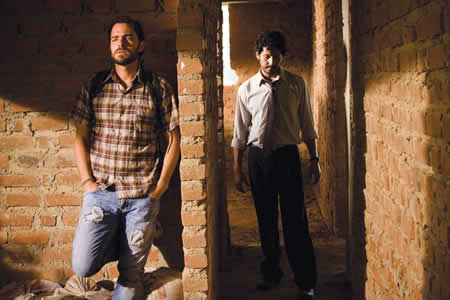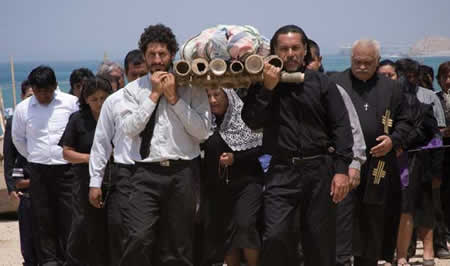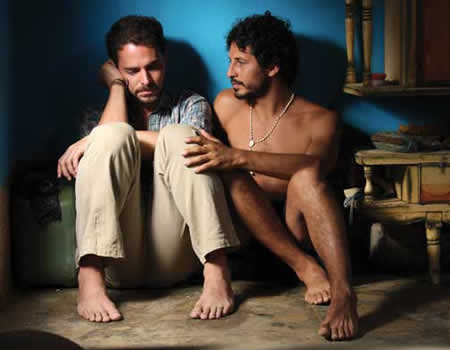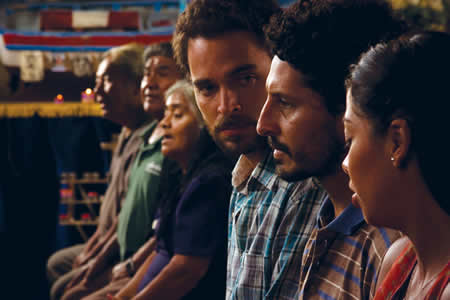 In Undertow, a unique, gay romance and ghost story set on the beautiful Peruvian coastline, a married fisherman struggles to reconcile his devotion to his male lover within his world’s rigid traditions. Miguel (Cristian Mercado), a young fisherman, devoted husband, and beloved community member is about to welcome his first child along with his beautiful bride, Mariela (Tatiana Astengo). But Miguel harbors a scandalous secret: He’s in love with Santiago (Manolo Cardona), a handsome painter, ostracized by the town because he’s both agnostic and gay. When Santiago drowns accidentally in the ocean’s strong undertow, he cannot pass peacefully to the other side. His spirit returns after his death to ask Miguel to look for his body and bury it according to the rituals of the town. Miguel must choose between sentencing Santiago to eternal torment, or doing right by him and, in thus, revealing their relationship to Mariela—and the entire village.
In Undertow, a unique, gay romance and ghost story set on the beautiful Peruvian coastline, a married fisherman struggles to reconcile his devotion to his male lover within his world’s rigid traditions. Miguel (Cristian Mercado), a young fisherman, devoted husband, and beloved community member is about to welcome his first child along with his beautiful bride, Mariela (Tatiana Astengo). But Miguel harbors a scandalous secret: He’s in love with Santiago (Manolo Cardona), a handsome painter, ostracized by the town because he’s both agnostic and gay. When Santiago drowns accidentally in the ocean’s strong undertow, he cannot pass peacefully to the other side. His spirit returns after his death to ask Miguel to look for his body and bury it according to the rituals of the town. Miguel must choose between sentencing Santiago to eternal torment, or doing right by him and, in thus, revealing their relationship to Mariela—and the entire village.
Winner of the World Cinema Audience Award (Drama) at the 2010 Sundance Film Festival, and Outstanding First Feature Award at 2010 Frameline Festival, Undertow is Peru’s Official Selection for the Oscars. We interviewed the director of Undertow, Javier Fuentes-Leon about this film and his career as a filmmaker.
Bijan Tehrani: My First question is, how did you come up with the idea of Undertow?
Javier Fuentes-Leon: The idea for Undertow was a little bit of an accident. I was studying film in LA and was taking a screenwriting class and we were asked to write a scene with no more than  three characters and to create several conflicts between them. I ended up writing a scene that became the seed of the movie and it was this scene that produced the whole magical aspect of the film. That’s the scene where the fisherman walks into the house and finds his lover in there and realizes that his wife cannot see him. I wrote that in ‘96 and later in 2001. I worked on the later version of the screenplay, so I took that scene and decided to write a story that contained ideas and issues that were very important to me; I would talk about homosexual love and put it on the same plane as heterosexual love and would then talk about what it means to be a man and societal views on what being a man means and also the fight to be faithful to yourself.
three characters and to create several conflicts between them. I ended up writing a scene that became the seed of the movie and it was this scene that produced the whole magical aspect of the film. That’s the scene where the fisherman walks into the house and finds his lover in there and realizes that his wife cannot see him. I wrote that in ‘96 and later in 2001. I worked on the later version of the screenplay, so I took that scene and decided to write a story that contained ideas and issues that were very important to me; I would talk about homosexual love and put it on the same plane as heterosexual love and would then talk about what it means to be a man and societal views on what being a man means and also the fight to be faithful to yourself.
BT: One thing that I noticed which is very interesting is that the film is told through the magical storytelling of Gabriel Garcia Marquez. Are you interested in that kind of storytelling of fairy tales and the culture of Peru?
JFL: I grew up reading a lot of those American books and I don’t know if I consciously sit down and write something but usually when stories come to me, there is always some fantasy involved. I feel that writing fantasy can be very liberating when you’re writing because it allows you to write about present and actual themes and topics but it also gives you the freedom to create the world that you want. Yes, I agree that it is very present in American literature and film, so I feel that I am doing a little bit of homage to those films. Also, Midnight Children by Salmon Rushdie is a novel  that I drew a lot of influence from.
that I drew a lot of influence from.
BT: How has the Peruvian reaction been to the film?
JFL: The reaction has been very good. I was actually expecting there to be more of a resistance to the film, especially from the government, but this film is actually partially financed by the Peruvian film commission, which is of course run by the government. The commission is also the entity that selected the film to be entered into the selection at the Oscars. Of all of the Peruvian films that have premiered this year, this film has had the biggest box office success by far. But still, this film deals with a topic that is an obstacle for a lot of people. The thought of two men being affectionate toward one another is still a reason for many people to not see the film.
BT: How did you go about casting the Undertow?
JFL: Tatiana Astengo, who is the actress that plays Mariela, is a very well known Peruvian actress that I always really admired. She has a lot of internal strength as an actress and I wanted the character to be a strong woman and not a submissive woman that is just an obstacle. I wanted an actress that could add a lot of power to that performance. In terms of the two guys, the film was partially financed through Columbia, and one of the requirements was that I would need to have Columbians on the cast and crew and this would make sense, seeing as how the outsider would  have to be an actor that was not from Peru. So when I met Manolo Cardona, who is actually a big star in Columbia, he fell in love with the script and I was very happy that he said yes. He had this charisma that really fit the part of Santiago. In terms of Christian Mercado, who plays Miguel, I had help from a friend of mine who is a filmmaker from Bolivia who actually did casting for Steven Soderbergh for his Che films. He recommended Christian; when I saw him do scene for the film, I decided that, yes, he was the one.
have to be an actor that was not from Peru. So when I met Manolo Cardona, who is actually a big star in Columbia, he fell in love with the script and I was very happy that he said yes. He had this charisma that really fit the part of Santiago. In terms of Christian Mercado, who plays Miguel, I had help from a friend of mine who is a filmmaker from Bolivia who actually did casting for Steven Soderbergh for his Che films. He recommended Christian; when I saw him do scene for the film, I decided that, yes, he was the one.
BT: The location plays a great part in the film; it is almost like its own character. How did you pick the location of the film?
JFL: I wrote the script not knowing exactly where I was shooting. I shot in the northern area of Peru, because it has some beautiful landscapes. I did a bit of a road trip through Peru and went to every fishing village in the area and when I found this town, I really fell in love with it. Also the geography of the town: it’s a town that is stuck between the hills and ocean, and it is a metaphor that is stuck in between society and that is why he is so afraid of what is expected of him. You need to be able to believe that pressure that the main character feels and for all of these reasons, I thought that the location was great.
BT: How did you come up with the visual style of the film?
JFL: I’m a strong believer that the visual style has to be in the service of the main character and the performance. I wanted the camera to be a witness to what was happening, so I was always conscious when placing the camera that I wanted it to be economical and that with just small movements of camera, that you could continue seeing what was happening in each scene. I wanted the camera to move with the actors and not the other way around. I did not want the photography to be beautified and at the same time not ugly so that it would detract from the actors. Most of the locations that we shot at are exactly how we found them; we wanted the film to be as natural as possible. I didn’t want to be overbearing with the camera and the visual style.
BT: What is your next project?
JFL: I’m working on a couple different projects. They fall in the same thematic trilogy as Undertow where they are love stories with big obstacles, but with these it is between a man and a woman. One is about a woman who cannot go out into the sunlight because she burns into flames, so she lives isolated in the forest. A human cannonball character creates a hole in her roof right before sunrise, and the story evolves from there. The other film is a Romeo and Juliet film set in the present.
BT: We are looking forward to more of your unique works! Thank you for your time!

